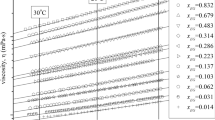Summary
The temperature dependence of density, viscosity, contact angle, and surface tension of Unox Epoxide 201 were determined. The motion of a real liquid in capillary tubes is characterized generally by the equation
This equation in its simplest approximation was used for evaluating the rate of flow of Unox Epoxide 201 and glycerol through capillary tubes and for evaluating the rate of wetting of closely packed glass fibers. The time function is common in both cases and its constants depend on the properties of the liquid and on the nature of glass fiber surface. The temperature coefficient of the flow rate was compared with the activation energy of viscous flow of Unox Epoxide 201 and glycerol and an attempt was made to interpret a non-isothermal course of glass fiber wetting in a model arrangement.
The work of adhesion is significantly influenced by the nature of previous treatment of glass surface, e. g. the usual textile size decreases the work of adhesion by one half. In the system Unox Epoxide 201 — glass fibers, spreading is to be expected at temperatures about 200 ‡C.
Zusammenfassung
Die TemperaturabhÄngigkeit der Dichte, der ViskositÄt, des Kontaktwinkels und der OberflÄchenspannung von Unox Epoxide 201 wurde bestimmt. Die Bewegung einer realen Flüssigkeit durch ein Rohr wird allgemein mit der folgenden Gleichung charakterisiert:
Diese Gleichung wurde in ihrer einfachsten AnnÄherung zum Auswerten der Flie\geschwindigkeit von Unox Epoxide 201 und Glyzerin durch Kapillaren und zum Auswerten der Benetzungsgeschwindigkeit von dicht zusammengepackten Glasfasern herangezogen. Die Zeitfunktion ist für beide FÄlle gemeinsam, und ihre Konstanten sind von den Eigenschaften der Flüssigkeit und von dem Zustand der GlasfaseroberflÄche abhÄngig. Der Temperaturkoeffizient der Flie\geschwindigkeit wurde mit der Aktivierungsenergie des viskosen Flie\ens von Unox Epoxide 201 und Glyzerin verglichen, und ein Versuch ist unternommen worden, den Ablauf einer nichtisothermen Benetzung der Glasfaser in Modellbedingungen zu erlÄutern. Eine befriedigende übereinstimmung der experimentellen Ergebnisse mit der theoretisch berechneten Kurve wurde gefunden. Die AdhÄsionsarbeit ist von der Natur der vorlÄufigen Behandlung der GlasfaseroberflÄche stark beeinflu\t; die übliche Textilschlichte setzt z. B. die AdhÄsionsarbeit etwa auf die HÄlfte herab. Das Spreiten in dem System Unox Epoxide 201 — Glasfaser kann bei Temperaturen um 200 ‡C vorkommen.
Similar content being viewed by others
Abbreviations
- a 1, a 2, a 3, a 4, m, n, p, q, j :
-
constants
- \(b = \frac{{d\cos \theta _A }}{{d\frac{{dh}}{{d\tau }}}}\) :
-
change of contact angle with rate increase [cm−1 sec]
- g=981:
-
gravity constant [cm sec−2]
- h :
-
distance of meniscus from the origin of the capillary tube [cm]
- h R :
-
perpendicular distance of the outer liquid level from the origin of the capillary tube [cm]
- h ∞ =2γ cos σ/rϱg :
-
capillary rise [cm]
- x=¦h r −h¦:
-
instantaneous distance of the liquid level from the equilibrium level [cm]
- k :
-
rate of temperature increase [grad min−1]
- t :
-
temperature [‡C]
- T :
-
temperature [‡K]
- A :
-
gr 2 g9/8η [cm sec−1]
- B :
-
γrb/4η [cm]
- E :
-
activation energy of viscous flow [cal mole−1]
- P :
-
frequency factor in the Arrhenius equation [g cm−1 sec−1]
- R 1.98:
-
gas constant [cal grad−1 mole−1
- V :
-
volume
- F :
-
adhesion tension [dyn cm−1]
- −δH/A :
-
heat of wetting per surface unit A [erg cm−2]
- S :
-
spreading coefficient [erg cm−2]
- W a :
-
work of adhesion [erg cm−2]
- W k :
-
work of cohesion [erg cm−2]
- 0 :
-
static contact angle
- 0 A :
-
anteceding contact angle
- ϱ :
-
density [g cm−3]
- α :
-
coefficient of thermal expansion [grad−1]
- η :
-
viscosity [g cm−1 sec−1]
- γ :
-
surface tension [dyn cm−1]
- Τ :
-
time [sec]
References
Bikerman, J. J., Science of adhesive joints (New York 1961).
Kanamaru, K., Kolloid-Z. u. Z. Polymere 192, 51–66 (1963).
Bikerman, J. J., Amer. Chem. Soc. Div. Polymer Chem. Preprints 5 (2), 566–573 (Sept. 1964).
Huntsberger, J. R., J. Polymer Sci. A 1, 2241 bis 2250 (1963).
Huntsberger, J. R., Adv. Chem. Ser. No. 43, 180–188 (1964).
Bikerman, J. J., T.A.P.P.I. J., 44, 568–570 (1961).
Rose, W. and R. W. Heins, J. Coll. Sci. 17, 39–48 (1962).
ZvonaŘ, V., Coll. Czech. Chem. Comm., to be published.
ZvonaŘ, V. and A. Zahradníková, Chemický průmysl 15, 242–244 (1965).
Bikerman, J. J., Ind. Engng. Chem. 13, 443–444 (1941).
ZvonaŘ, V., Chemický průmysl 15, 300–303, (1965).
Bikerman, J. J., Surface chemistry (Acad. Press, New York 1948).
ZvonaŘ, V., Plastické hmoty a kaučuk 1, 293–298 (1964).
Vallet, P., Tables numériques (Gauthier-Villars, Paris 1961).
Sherman, J., Ind. Engng. Chem. 28, 1026–1031 (1956).
Doyle, C. D., J. Applied Polymer Sci. 5, 285–292 (1961).
Eley, D. D., Kolloid-Z. u. Z. Polymere 197, 129–134 (1964).
Trostyanskaya, E. B., A. M. Poimanov, and Yu. N. Kazanskii, Plasticheskie massy (1964) No. 8, 20–23.
Author information
Authors and Affiliations
Rights and permissions
About this article
Cite this article
ZvonaŘ, V. Wetting of glass-surface with polar liquids. Kolloid-Z.u.Z.Polymere 212, 113–118 (1966). https://doi.org/10.1007/BF01553075
Received:
Issue Date:
DOI: https://doi.org/10.1007/BF01553075



